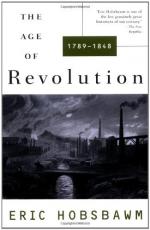
|
| Name: _________________________ | Period: ___________________ |
This test consists of 5 multiple choice questions, 5 short answer questions, and 10 short essay questions.
Multiple Choice Questions
1. Where were spinning and weaving performed prior to the Industrial Revolution?
(a) In warehouses.
(b) In communal workshops.
(c) At home.
(d) In the market.
2. What was the international congress that ruled Europe called?
(a) The European Assembly.
(b) The League of Nations.
(c) The European Convention.
(d) The Concert of Europe.
3. What emerged in 1830, according to Hobsbawm's evaluation?
(a) A self-identified working class.
(b) Mechanisms for suppressing revolutions.
(c) State surveillance techniques.
(d) A permanently poor underclass.
4. Why didn't disagreements between nations reach the level of international war?
(a) Because there was a relative balance of powers.
(b) Because the treaties signed after the French Revolution forbade it.
(c) Because the populaces had all been decimated.
(d) Because the nations were bound by alliances.
5. Where did Russia expand its relationships after the French Revolution?
(a) China.
(b) Greece.
(c) The Caucasus.
(d) Japan.
Short Answer Questions
1. What product does Hobsbawm say was the catalyst for the Industrial Revolution?
2. What was the age of scientific and political progress in the 1700s called?
3. How did the concept of nationalism spread through Europe?
4. Which industry saw special improvements and expansion in the late 1700s, according to Hobsbawm?
5. How large were the circles within which people moved in the late 1700s, according to Hobsbawm?
Short Essay Questions
1. Describe the beginnings of the French Revolution, from 1789 to 1792.
2. In what way does Hobsbawm say that the world was both bigger and smaller in the late 1700s?
3. In Hobsbawm's account, why was 1830 a turning point in the history of Europe?
4. What was the importance of railroads, in Hobsbawm's account, in the Industrial Revolution?
5. What does Hobsbawm say was the paradox of progress in certain countries of Europe?
6. Why does Hobsbawm say that raw materials like iron and coal did not expand the same way as cotton began to expand in the 1780s?
7. Describe the final defeat of the French forces at the end of the Napoleonic Wars.
8. In Hobsbawm's account, how strong were the major European nations by the end of the Napoleonic Wars?
9. What role did the cotton market play in the Industrial Revolution, in Hobsbawm's account?
10. Where does Hobsbawm say the European nations expanded their influence, for lack of war in Europe?
|
This section contains 766 words (approx. 3 pages at 300 words per page) |

|




